RHINOSHIELD x Van Gogh Museum Virtual Tour

What would life be if we didn’t dare to take things in hand?
– Vincent van Gogh to his brother Theo, 29 December 1881
Welcome to the Van Gogh Museum virtual tour! In this article, we share our inspiration behind our new case collection, and bring you along to discover a small part of Vincent van Gogh's world and artistic journey.
With the RHINOSHIELD x Van Gogh Museum collection, we wanted to encourage everyone to have “the courage to attempt anything”, as Van Gogh did. To convey this message, we selected pieces with distinctive painting styles to represent 3 important points in his career.
Through this series, we can observe how his iconic style was developed as a result of his many trials and experimentations with different techniques.
Life of Vincent van Gogh
Vincent van Gogh (1853-1890) is one of the most famous Dutch artists of all time. He was only active as an artist for ten years: from 1880 until his death in 1890.
As a result of his enormous passion, in those ten years Van Gogh produced an impressive body of work: about 850 paintings and more than 1300 drawings have been preserved, as well as a large number of watercolours, lithographs, and sketches in letters.
Throughout his life, Van Gogh wrote hundreds of letters to his brother Theo, and to other family members and friends. For him, these letters were an important means of communication, and an outlet for his feelings. Much of what we now know about Van Gogh's life, his background, and what he read, saw and thought, comes from his own ‘biography’: his letters.
As a painter, he was largely self-taught. With the help of textbooks, a few lessons at the art academies of Brussels and Antwerp, visits to museums, and advice from artist friends, he taught himself the craft. His introduction to modern French art movements encouraged him to experiment. As the years went by, he developed his own, highly distinctive style of painting, using expressive brushstrokes and vivid colours. This style has since inspired and influenced many subsequent generations of artists.
After Van Gogh’s death, there was a great deal of interest in the artist’s work, and almost as much fascination with his dramatic life story: his unhappy romances, his apparent lack of recognition, his illness, and his suicide.
A multifaceted artist
Some designs in the collection include a small portrait or a representative painting alongside the main artwork to illustrate Van Gogh's range as an artist, and his constant efforts to express his current self through his paintings.
‘People say – and I’m quite willing to believe it – that it’s difficult to know oneself – but it’s not easy to paint oneself either.’ – Vincent van Gogh to his brother Theo, 5 September 1889
Self-Portrait with Grey Felt Hat


Van Gogh painted this self-portrait in the winter of 1887–88, when he had been in Paris for almost two years. It is clear from the work that he had studied the technique of the Pointillists and applied it in his own, original way. He placed the short stripes of paint in different directions. Where they follow the outline of his head, they form a kind of halo. The painting is also one of Van Gogh’s boldest colour experiments in Paris. He placed complementary colours alongside one another using long brushstrokes: blue and orange in the background, and red and green in the beard and eyes. The colours intensify one another. The red pigment has faded, so the purple strokes are now blue, which means the contrast with the yellow is less powerful.
Courtesan (after Eisen)

Van Gogh based this painting on a woodcut by the Japanese artist Keisai Eisen. The print had been reproduced on the cover of the magazine "Paris illustré" in 1886. Van Gogh used a grid to copy and enlarge the Japanese figure. He used bright colours and bold outlines, as if it were a woodcut. We can tell the woman is a courtesan by her hairstyle and the belt (obi) that she is wearing, which is tied at the front of her kimono rather than at the back. Van Gogh framed her with a pond full of water lilies, bamboo stems, cranes and frogs. This scene has a hidden meaning: grue (crane) and grenouille (frog) were French slang words for 'prostitute'.
Head of a Skeleton with a Burning Cigarette

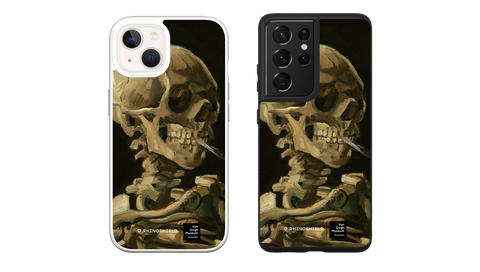
This skeleton with a lit cigarette in its mouth is a juvenile joke. Van Gogh painted it in early 1886, while studying at the art academy in Antwerp. The painting shows that he had a good command of anatomy. Drawing skeletons was a standard exercise at the academy, but painting them was not part of the curriculum. He must have made this painting at some other time, between or after his lessons.
Skull



A skull is monochrome, but Van Gogh used many different colours to paint this one. Could he produce a convincing image of it in this way? This seems to have been the question in Van Gogh’s mind when he made this study in colour. He has suggested the shiny surface of the skull by zigzagging a heavy brushload of white paint across it.
Bridge in the Rain (after Hiroshige)



Van Gogh greatly admired Japanese woodcuts for their bright colours and distinctive compositions. He based this painting of a bridge in the rain on a print by the famous artist Utagawa Hiroshige. Van Gogh made the colours more intense than in the original, however. He painted this work on a standard size canvas. He wanted to maintain the proportions of the original print and so left a border, which he filled with Japanese characters copied from other prints.
The Pink Peach Tree




Van Gogh painted many fruit orchards during his first weeks in Arles (FR). There is an earlier, nearly identical version of this painting, which Van Gogh had completed in one sitting. ‘I’d worked on a no. 20 canvas in the open air in an orchard — ploughed lilac field, a reed fence — two pink peach trees against a glorious blue and white sky. Probably the best landscape I’ve done’, he wrote. When he returned home, he saw the death notice of Anton Mauve (1838-1888), his uncle by marriage. Mauve was a well-known painter from whom Van Gogh had once taken lessons. He dedicated that first work to Mauve and made this new version later to send to Theo.
Sunflowers



Van Gogh’s paintings of Sunflowers are among his most famous. He did them in Arles, in the south of France, in 1888 and 1889. Vincent painted a total of five large canvases with sunflowers in a vase, with three shades of yellow ‘and nothing else’. In this way, he demonstrated that it was possible to create an image with numerous variations of a single colour, without any loss of eloquence. The sunflower paintings had a special significance for Van Gogh: they communicated ‘gratitude’, he wrote. He hung the first two in the room of his friend, the painter Paul Gauguin, who came to live with him for a while in the Yellow House. Gauguin was impressed by the sunflowers, which he thought were ‘completely Vincent’. Van Gogh had already painted a new version during his friend’s stay and Gauguin later asked for one as a gift, which Vincent was reluctant to give him. He later produced two loose copies, however, one of which is now in the Van Gogh Museum.
Almond Blossom





Large blossom branches like this against a blue sky were one of Van Gogh’s favourite subjects. Almond trees flower early in the spring making them a symbol of new life. Van Gogh borrowed the subject, the bold outlines and the positioning of the tree in the picture plane from Japanese printmaking. The painting was a gift for his brother Theo and sister-in-law Jo, who had just had a baby son, Vincent Willem. In the letter announcing the new arrival, Theo wrote: ‘As we told you, we’ll name him after you, and I’m making the wish that he may be as determined and as courageous as you.’ Unsurprisingly, it was this work that remained closest to the hearts of the Van Gogh family. Vincent Willem went on to found the Van Gogh Museum.
Irises




Van Gogh painted this still life in the psychiatric hospital in Saint-Rémy. For him, the painting was mainly a study in colour. He set out to achieve a powerful colour contrast. By placing the purple flowers against a yellow background, he made the decorative forms stand out even more strongly. The irises were originally purple. But as the red pigment has faded, they have turned blue. Van Gogh made two paintings of this bouquet. In the other still life he contrasted purple and pink with green.
Wheatfield with Crows


Wheatfield with Crows is one of Van Gogh's most famous paintings. It is often claimed that this was his very last work. The menacing sky, the crows and the dead-end path are said to refer to the end of his life approaching. But that is just a persistent myth. In fact, he made several other works after this one. Van Gogh did want his wheatfields under stormy skies to express 'sadness, extreme loneliness', but at the same time he wanted to show what he considered 'healthy and fortifying about the countryside'. Van Gogh used powerful colour combinations in this painting: the blue sky contrasts with the yellow-orange wheat, while the red of the path is intensified by the green bands of grass.
The world through the eyes of Vincent van Gogh
Vincent van Gogh was a post-impressionist painter whose work highly influenced 20th century art. Throughout his artistic journey, he absorbed influences and incorporated them into his works to create highly innovative artworks, ranging from portraits of working people performing simple tasks, everyday objects, and landscapes.
Introducing the legendary artist through different lens, the second wave of our RHINOSHIELD x Van Gogh Museum collaboration aims to show the world through the eyes of Vincent van Gogh, through select pieces that showcase scenes from his daily life and landscapes, as well as paintings by Monet, Lepère, Hokusai, and Hiroshige, who profoundly influenced his art and the way he depicted what he saw.
Montmartre: Windmills and Allotments


In Paris, Van Gogh frequently painted the picturesque windmills on the hill of Montmartre. In his day, Montmartre was still a partly rural area with allotment gardens and farms. Van Gogh hoped that this subject would sell well. He took the fresh, pure colours – the white of the fields and bright blue of the sheds – from contemporary French art. To render sunlight in this landscape, Van Gogh used highly diluted oil paint. This resulted in a translucent, matt effect. He chose a canvas with an unusual, elongated shape. That creates an effect like that of a wide-angle lens. The paths and gardens fan out, drawing our eyes toward the horizon.
Kingfisher by the Waterside


This kingfisher sits by the waterside, on the lookout for fish. Van Gogh had a mounted kingfisher, which has been preserved. Comparing this painting to the mounted bird, one notices a couple of differences. Van Gogh made the tail slightly longer in the painting, probably to achieve a balance with the raised beak. He also gave the bird feet – useful to have when perched on a reed stem. The kingfisher's brilliant blue plumage looks a little dull here.
Sprig of Flowering Almond in a Glass


A red line divides the picture plane. Van Gogh used the same red to sign this small painting of a sprig of flowering almond. Almond trees are the first to blossom in the spring. When Van Gogh arrived in Arles (France), there was still snow on the ground. On 2 March, a little more than a week later, he wrote to his brother, 'There’s a hard frost here, and out in the country there’s still snow — I have a study of a whitened landscape with the town in the background. And then 2 little studies of a branch of an almond tree that’s already in flower despite everything.' After that, Van Gogh began work on a large series of paintings of flowering orchards: almond, peach, plum and pear trees.
Seascape near Les Saintes-Maries-de-la-Mer



We can tell that Van Gogh painted this view of the sea from the beach, as grains of sand have been found in the paint layers. It was done at the fishing village of Les Saintes-Maries-de-la-Mer, during a trip he took from Arles in the south of France. In addition to the blue and white that he brushed onto the canvas with bold strokes, he used green and yellow for the waves. He applied these colours with a palette knife, neatly capturing the effect of the light through the waves. Van Gogh was enthusiastic about the colours of the Mediterranean Sea. He wrote that it ‘has a colour like mackerel, in other words, changing – you don’t always know if it’s green or purple – you don’t always know if it’s blue – because a second later, its changing reflection has taken on a pink or grey hue’. The bright red signature has been placed prominently in the foreground: it was intended as a ‘red note in the green’.
The Harvest

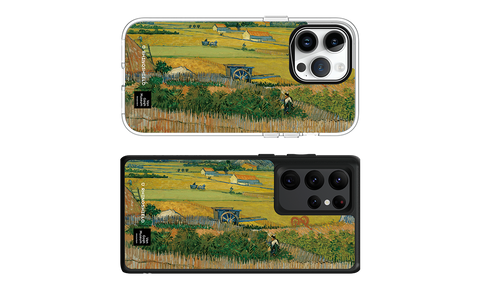
You can almost feel the dryness and heat in this painting of the flat landscape around Arles in the south of France. Van Gogh combined the azure blue of the sky with yellow and green tones for the land to capture the atmosphere of a summer’s day. He worked in the wheatfields for days at a time under the burning sun. This was an immensely productive period, in which he completed ten paintings and five drawings in just over a week, until a heavy storm brought the harvest season to an end. Van Gogh wanted to show peasant life and work on the land – a recurring theme in his art – and painted several stages of the harvest. We see a half mowed wheatfield, ladders and several carts. A reaper works in the background, which is why he titled the work La moisson or 'The Harvest'. Van Gogh considered it one of his most successful paintings, writing to his brother Theo that the ‘canvas absolutely kills all the rest’.
Fishing Boats on the Beach at Les Saintes-Maries-de-la-Mer
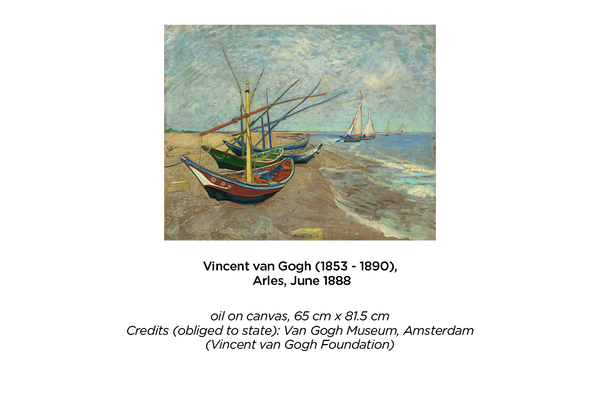
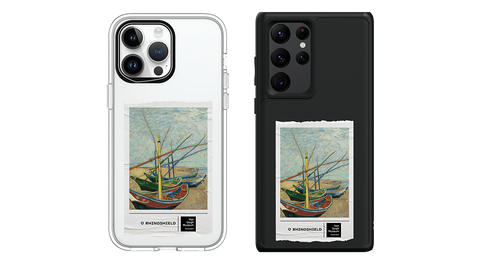

Can you see why these fishermen's boats appear slightly unreal? Compared to the irregular surface of the sandy beach, they've been painted in an overly two-dimensional way. The boats are made up of areas of uniform colour within strong outlines. Furthermore, the boats don't cast shadows on the beach. These stylistic elements were familiar to Van Gogh from his collection of Japanese prints. Van Gogh would have preferred to make this painting on the beach, but he couldn't, because the fishermen put out to sea very early every morning. He did draw the boats there, however, and later made this painting at home.
The Yellow House (The Street)


In May 1888, Van Gogh rented four rooms in a house on Place Lamartine in Arles (southern France). The green shutters in this painting of the square show where he lived. Shortly after moving into the ‘Yellow House’, he sent Theo a description and sketch of his painting of it: ‘it’s tremendous, these yellow houses in the sunlight and then the incomparable freshness of the blue.’ The work, which Van Gogh himself called ‘The Street’, records the artist’s immediate surroundings: he often ate at the restaurant on the left, and the home of his friend, the postman Joseph Roulin, lay just beyond the second railway bridge. Vincent had finally found a place at the Yellow House where he could not only paint but also have his friends come to stay. His plan was to turn the yellow corner-building into an artists’ house, where like-minded painters could live and work together.
Sketch of Starry Night Over Rhône


This is a Sketch of the famous painting 'Starry Night Over the Rhône', which was enclosed in a letter from Vincent van Gogh to Eugène Boch and it originally was a crossed-out, unsent fragment of a letter written by Van Gogh to Gauguin.
The Outskirts of Koshigaya in Musashi Province, from the series Thirty-Six Views of Mount Fuji
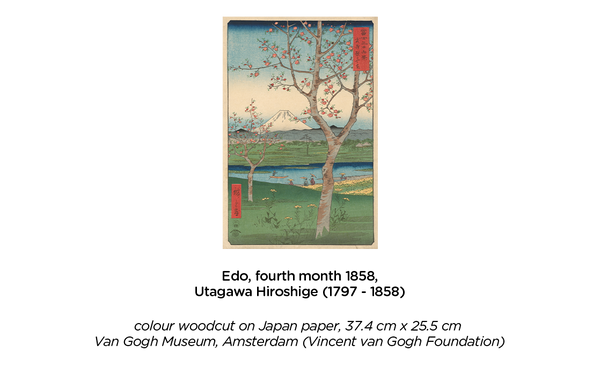

Thirty-six Views of Mount Fuji (Japanese: 富士三十六景 Fuji Sanjū-Rokkei) is the title of two series of woodblock prints by Japanese ukiyo-e artist Hiroshige, depicting Mount Fuji in differing seasons and weather conditions from a variety of different places and distances. The 1852 series, published by Sanoya Kihei, are in landscape orientation using the chūban format, while the 1858 series are in the portrait ōban format and were published by Tsutaya Kichizō. The same subject had previously been dealt with by Hokusai in two of his own series, Thirty-six Views of Mount Fuji, produced from c. 1830 to 1832, and One Hundred Views of Mount Fuji, published in three volumes from 1834 to 1849. This print shows Mount Fuji from Musashi Province in modern Kanagawa City and is part of the second series from 1858.
Cherry Blossoms and Shrike


Van Gogh was inspired by these types of Japanese prints, which are called kachōga. Japanese artists often took their subjects from nature, like in this print from a series with flowers and birds. These were traditionally pictured together, sometimes with a poem. In Japan, the vibrant prints were used in interiors: they were stuck on walls or screens. Van Gogh also hung Japanese prints on his wall. He loved the attention to detail, as you can also see in his own work.
Tulip Fields near The Hague



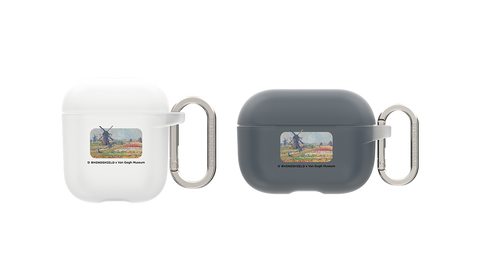
(This work is part of the Netherlands Art Property Collection (Nederlands Kunstbezit-collectie) consisting of works recovered from Germany after World War II and held in trust by the Dutch State. The work is on loan to the Van Gogh Museum) Claude Monet was enormously impressed by the brightly coloured bulb fields of Holland. In the early spring of 1886, he wrote to a friend that the sight was ‘impossible to convey with our poor colours’. Monet had been to the Netherlands before but was painting the sea of flowers for the first time. Back in Paris, he sold the painting via art dealers Boussod, Valadon & Cie, where Theo van Gogh worked. It’s quite possible that his brother Vincent saw it there. Vincent gradually came to admire Monet’s swift brushstrokes and bright colours.
The Palais de Justice, Seen from the Pont Notre-Dame
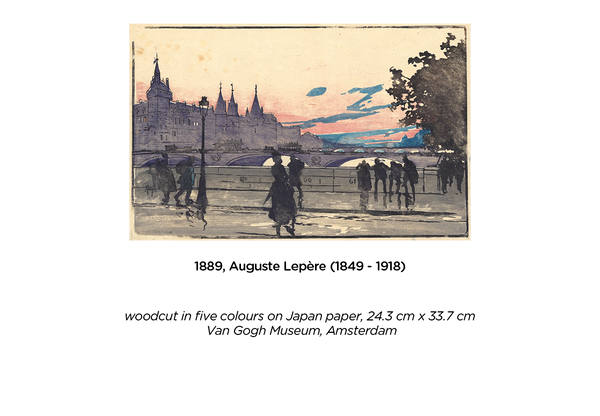
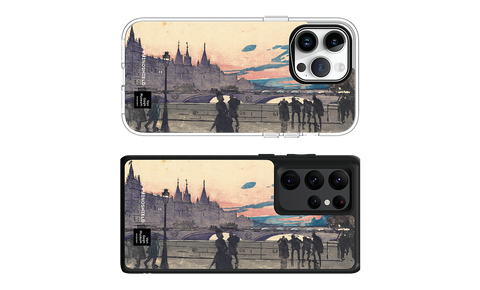
Auguste Lepère was born and worked in Paris and by 1889 when “The Palais de Justice” was made Lepère had become one of the most renowned printmakers of his generation. With its subtle, blended, liquid colors printed on smooth, lustrous paper, this woodcut displays Auguste Lepère’s mastery of techniques derived from Japanese woodcuts, which were enormously popular in France during the later 1800s. It especially recalls the work of Utagawa Hiroshige, whose atmospheric compositions often involved figures crossing bridges. This influence from the east was taken up by Vincent van Gogh and Claude Monet among others.
Inspiring the next generation
It is an honour for us to have the opportunity to help make Van Gogh's works more accessible to a wider audience in the way we know best: protected in the strongest frame, faithfully presented with the highest print and color quality, and available at the palm of your hands. We hope this collection will inspire you to try learning a new skill, discover a new hobby, and keep in mind that there are no failures, only valuable experiences.
Explore the RHINOSHIELD x Van Gogh Museum full protective phone, phone grips, and AirPods case collection here.
Learn more about Van Gogh's life and works at Van Gogh Museum's official webpage here.






